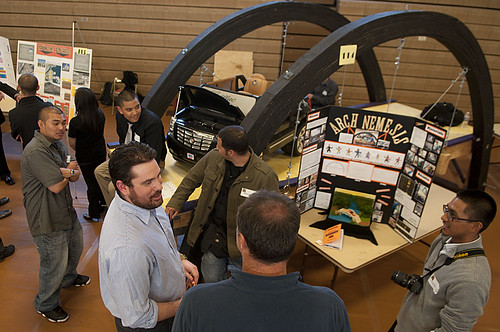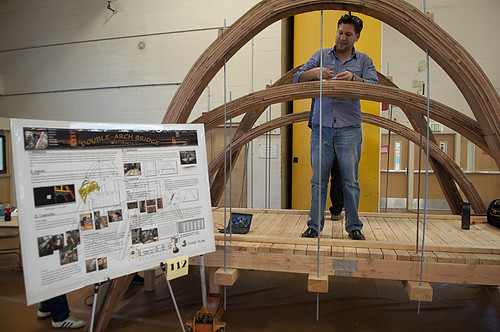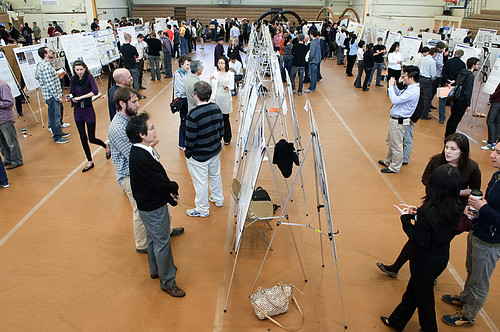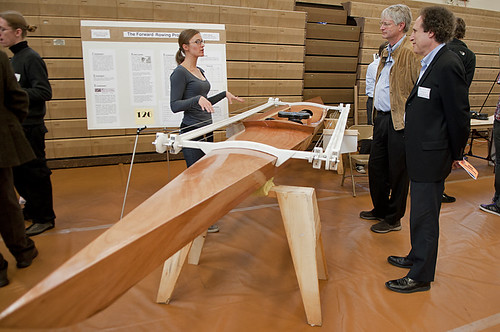Science buffs and engineering enthusiasts gathered in the main gym at San Francisco State May 13 to present their projects at the 13th annual College of Science and Engineering Student Project Showcase.
The showcase allowed both graduates and undergraduates to present biological science and physical science related projects and receive feedback from their peers, professors and judges.

Approximately 300 students presented 128 projects, some of which had taken years of preparation.
“It really highlights the best,” said event coordinator Lannie Nguyen-Tang. “The students put a lot of effort in these.”
Projects ranged from remote-controlled gadgets to models of buildings and bridges.
“It’s great to see all the gadgets of the tables, and I like that students are proud of it,” Nguyen-Tang said.
The participants gained not only hands-on experience from working in their field, but several also won cash prizes up to $500.
“We’re looking for high-quality students and high-quality presentations,” said Ron Powell, a judge at the event.
Powell, who is a fellow at technology company Novellus Systems said he was impressed with the projects.
“The diversity and the quality is all really good,” Powell said.
Though many of the students were enthused about presenting their work to their peers and being judged at the showcase, many had already placed in other competitions around the nation.
One group of students built a double-arched bridge that won first place for both innovative design and most aesthetic design in the National Timber Bridge Design competition.
“I’m proud of it,” said 23-year-old senior Clarence Li. “Even if it fell over, I’d still be proud of it.”
Li said that his team decided to build a bridge with two arches instead of one for aesthetic reasons, but they quickly learned that it was the most difficult part of their project.
“It was tough,” said Chokri Sahkri, 32, senior. “But once you see the fruit after you plant the seed, it’s great.”
The Arch Nemesis Wood Bridge group also entered the National Timber Bridge Design Competition and placed second in best overall design. Their bridge is capable of holding 4,500 pounds.
Together, they spent approximately eight months planning and constructing the bridge.
“We all put in our own expertise,” said 24-year-old senior Randy Dilag. “Some people were good at design and some in construction.”
Another group, the SFSU Steel Bridge Team, decided to build a steel bridge instead.
They adhered to the American Institute of Steel Construction Student Steel Bridge Competition rules and spent nine months working on the project.
“It was fun, but the last month was stressful,” said 24-year-old senior Corey Wageman. “The biggest problem was that we had to hire out for welding.”
Other engineering majors chose to work on projects that reflected their personal hobbies and interests.
Heather Esposito, a 27-year-old mechanical engineering junior, decided to build a front-rowing rowboat because she doesn’t like to face backward when she is rowing in a traditional rowboat.
Instead, she built a contraption using pulleys and ropes that directs the energy she would normally exert in the opposite direction.
“It won’t work perfectly because it’s still flawed, but it can be improved greatly,” Esposito said.
Esposito, a kayaker, has spent two semesters designing and building the project.
“I can’t wait to test it!” Esposito said.
While Esposito is still waiting to test out her final project, Alexandra Koba and Laura Johnson’s hemisection project has already been put to use at SF State.
“We took an anatomy class and we fell in love,” said Koba, 23. “We wanted to give back to the class. We wanted to give them a learning tool.”
Together, the physiology majors researched the head and neck and performed a hemi-section on a cadaver. The dissection has been used in anatomy classes to teach students about the human body.
“I like teaching other people what we’re doing and getting feedback,” said Johnson, 27.
Some groups had troubles with their projects but have learned from their experience, as was the case with civil engineering major Luis Rodriguez, who spent nine months with his group designing and building a model of a multi-story commercial office building.
One of their models broke at the base because they used light-weight balsa wood as opposed to sturdier material.
“We made notes to next years’ team so they can improve theirs,” Rodriguez said.







